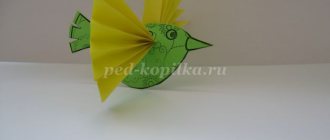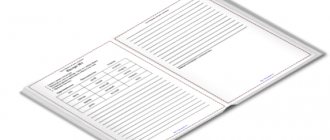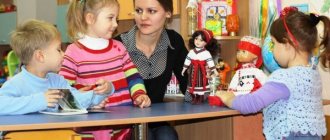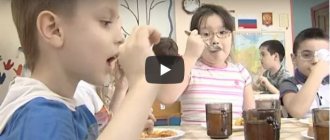Regulations on the inspection of design centers in preschool educational institutions
Approved by the Head of the Medical Educational Institution No. ____ ___________/______________
Pedagogical council No. 1 dated 24.08. 2022
Regulations on the “Design Centers” show
in MADOU No.___________ for the 2017-2018 academic year
Target:
Creating conditions in preschool educational institutions for the development of cognitive, research and productive (constructive) activities and artistic and creative abilities of children.
Objectives of the review:
- Replenish and update the supply of design centers.
- To contribute to improving the level of equipment of the developing subject-spatial environment of preschool educational institutions.
- To promote the development of the creative potential of preschool teachers.
- To improve the professional skills of teachers on the development of design skills in preschoolers.
- Help strengthen the connection between the preschool educational institution and the family.
Participants of the review:
Teachers and parents of all kindergarten groups, qualified specialists, and a senior teacher take part in the review.
commission
:
- _______________
- _______________
- _______________
- _______________
- _______________
Organization and procedure for the review:
The review is held on March 12-13, 2018.
Criteria for evaluation:
0—no criterion; 0.5 - partially present; 1-present in full. The maximum number of points is 5.
The results of the review of design centers are taken into account in teacher activity cards when distributing incentive payments.
| No. | Review indicators in groups (for teachers) | Taken into account | Maximum points |
| 1 | Creating conditions for organizing constructive activities in the group | 1 | |
| 1.1 | Age appropriate content | ||
| 1.2 | Openness and accessibility for children | ||
| 1.3 | Storage of children's works (ladder, shelf, rack) | ||
| 2 | Variety of materials | 1 | |
| 2.1 | Sets of cubes 4-12 pcs (younger age); floor building material; desktop building material (plastic construction sets: younger age - with large parts, older age - with small parts); construction sets with metal parts - older age; thematic sets (“City”, “Train”, etc.) - middle age; soft constructors on a carpet base - younger age. | ||
| 2.2 | Schemes, samples of buildings in drawings, drawings, etc.; photographs, albums with illustrations of cities, bridges, transport, houses, furniture, etc. | ||
| 2.3 | A box with accessories for construction (figures of people, animals, small cars, boats, airplanes, etc.) | ||
| 2.4 | Materials for construction from paper, natural materials, waste materials. | ||
| 3 | Compliance with health and safety requirements of equipment and materials | 1 | |
| 3.1 | Safety of equipment and materials | ||
| 3.2 | Compliance with hygiene requirements | ||
| 3.3 | Compliance with aesthetic requirements | ||
| 3.4 | Rational placement | ||
| 4 | Identifying initiative and a creative approach to creating conditions for children’s constructive activities | 1 | |
| 5 | Promoting the relationship between the preschool educational institution and the family | 1 | |
| 5.1 | Parents' participation in replenishing equipment and materials for children's constructive activities | ||
| 5.2 | Availability of visual information for parents on constructive modeling activities | ||
| Total points | 5 | ||
| No. | Review indicators for the methodological room (senior teacher, teacher of additional education in fine arts) | Taken into account | Maximum points |
| 1 | Creating conditions for organizing constructive activities in preschool educational institutions | 1 | |
| Availability of methodological manuals on the topic, systematization | |||
| 2 | A variety of materials for constructive activities in the teaching room | 1 | |
| 2.1 | Sets of building materials of different types | ||
| 2.2 | Materials for design, light construction | ||
| 2.3 | Schemes, samples of buildings in drawings, drawings, etc.; photographs, albums with illustrations of cities, bridges, transport, houses, furniture, etc. | ||
| 3 | Compliance with health and safety requirements of equipment and materials | 1 | |
| 3.1 | Safety of equipment and materials | ||
| 3.2 | Compliance with hygiene requirements | ||
| 3.3 | Compliance with aesthetic requirements | ||
| 3.4 | Rational placement | ||
| 4 | Identification of initiative and creative approach to creating conditions for constructive activities of children in preschool educational institutions | 1 | |
| 5 | Promoting the relationship between the preschool educational institution and the family | 1 | |
| Availability of visual information for parents on constructive modeling activities | |||
| Total points | 5 | ||
| No. | Review indicators for qualified specialists | Taken into account | Maximum points |
| 1 | Creating conditions for organizing constructive activities in the classroom | 1 | |
| Availability of teaching materials with design elements | |||
| 2 | Availability of construction materials in offices | 1 | |
| Sets of materials for design, diagrams, samples, albums with illustrations | |||
| 3 | Compliance with health and safety requirements of equipment and materials | 1 | |
| 3.1 | Safety of equipment and materials | ||
| 3.2 | Compliance with hygiene requirements | ||
| 3.3 | Compliance with aesthetic requirements | ||
| 3.4 | Rational placement | ||
| 4 | Identifying initiative and a creative approach to creating conditions for children’s constructive activities | 1 | |
| 5 | Promoting the relationship between the preschool educational institution and the family | 1 | |
| Availability of visual information for parents on constructive modeling activities | |||
| Total points | 5 | ||
Passport for the design corner in the middle group
Municipal state preschool educational institution Novosibirsk kindergarten No. 30 “Snegiryok”
Passport
design corner of the middle group No. 5 “Rainbow”
Compiled by: Maydanyuk O.N.
Novosibirsk 2022
Location
.
Middle group No. 5 “Rainbow”.
Goals of the
design corner:
- Increasing children's interest in creating structures and models;
— Improving design skills and abilities;
— Development of children’s creative potential;
— Providing preschoolers with the opportunity to express their attitude to the world around them through creative activities.
Main goals:
— Introduction to design, development of interest in constructive activities, familiarization with various types of designers.
— Developing the ability to work collectively, to combine their crafts in accordance with a common plan, to agree on who will do what part of the work.
— Formation of cognitive and research activity in a preschooler, the desire for mental activity, introduction to the world of technical and artistic invention.
Explanatory note
Children's creativity is a specific activity peculiar to the child, and is considered his universal ability. Creative activity satisfies the child’s cognitive activity, develops imagination and ingenuity. In the process of this activity, figurative ideas, imaginative thinking, and imagination develop.
Design as a type of children's creativity contributes to the active formation of technical thinking: thanks to it, the child learns the basics of graphic literacy, learns to use drawings, patterns, and sketches. The child himself makes markings, measurements, and builds diagrams based on independent analysis, which contributes to the development of his spatial and mathematical thinking. Construction introduces the child to the properties of various materials: building elements, paper, cardboard, fabric, natural, waste materials, etc.
When organizing construction and manual labor, the main attention is paid to developing children's powers of observation, curiosity, intelligence, resourcefulness, perseverance, and skill. It is important to develop in children the need for creative activity, hard work, independence, activity, patience, accuracy, and the desire to bring joy to the people around them; fill the child’s mental and creative interests with vivid content.
The program aims teachers to educate every child not as a performer, but as a creator. Therefore, it is necessary to take into account that the creation of buildings, structures, and crafts should not be an end in itself. First of all, it is a means of developing children's abilities (creative, intellectual, artistic). In this regard, the main objectives of the program for this section are the formation of cognitive and research activities in preschoolers, the desire for mental activity; introduction to the world of technical and artistic invention.
The methodology of design and artistic work is built in the context of different types of artistic activity and is actively included in the holistic educational process (in familiarization with the environment, in the development of speech, in the formation of mathematical concepts, etc.). Since, like all types of creative activity, design and manual labor are based on the impressions that children receive in the process of educational work, their content is closely related to the various buildings that children have the opportunity to constantly see. Children first examine and then construct residential buildings, schools, theaters, palaces, etc. from various materials. The older the children, the wider the range of their ideas, which is reflected in designs, buildings, and crafts.
Types and types of design in kindergarten:
There are two types of design: technical and artistic.
In technical design, children mainly display real-life objects, and also come up with crafts based on associations with images from fairy tales and films. At the same time, they model their main structural and functional features: a building with a roof, windows, a door; a ship with a deck, stern, and steering wheel. The technical type of design activity includes: design from building material (wooden painted or unpainted parts of geometric shape); constructing constructors from parts that have different fastening methods; construction from large-sized modular blocks.
In artistic design, children, when creating images, not so much reflect their structure as express their attitude towards them, convey their character, using color, texture, shape: “cheerful clown”, “angry wolf”, “prince charming”. The artistic type of design includes design from paper and design from natural material.
Let's consider the specifics of working
with middle-aged children 4-5 years old.
Draw children's attention to various buildings and structures around the kindergarten. On walks and during games, look at cars, carts, buses and other types of transport with children, highlighting their parts, name the shape of the parts and their location in relation to the largest part. Continue to develop in children the ability to distinguish and name construction parts (cube, plate, brick, block); learn to use them taking into account their structural properties (stability, shape, size). Develop the ability to establish associative connections by asking them to remember what similar structures children have seen. Learn to analyze a building sample: identify the main parts, distinguish and correlate them by size and shape, establish the spatial arrangement of these parts relative to each other (in houses - walls, at the top - ceiling, roof; in a car - cabin, body, etc.) .
Learn to independently measure buildings (in height, length and width), follow the design principle given by the teacher (“Build the same house, but tall”). Learn to build buildings from large and small building materials, use parts of different colors to create and decorate buildings.
Teach paper construction: bend a rectangular sheet of paper in half, matching the sides and corners (album, flags, greeting card), glue parts to the main shape (windows, doors, pipes to a house; wheels to a bus; back to a chair). Involve children in making crafts from natural materials (bark, branches, leaves, cones, chestnuts, nut shells, straw). Learn to use glue and plasticine to secure parts; use reels, boxes of different sizes and other items in crafts.
Features of the design of the corner for constructive activities in our group.
To ensure that design and modeling classes in our corner bring only joy and benefit to students, when organizing it we took into account the following points:
1. Safety - each construction set, both plastic and wooden, is constantly inspected during processing and washing, since the parts may have burrs, chips, etc., formed during use. We remove low-quality parts of the building material.
For independent creativity, we offer children materials that do not pose a danger: cones, walnuts, chestnuts, leaves, maple wings. Children make crafts using small materials (acorns, shells, bean seeds, sunflower seeds, etc.), as well as twigs, sticks, and pine needles under the supervision of a teacher.
We make sure to have conversations with children about the rules for using natural materials, small construction kit parts, scissors, glue, etc. teaching them to manage their behavior and take care of their own health.
2. Accessibility and convenience for children. The corner is located in such a place that children can easily approach it and have the opportunity to take all the material and use it. We follow the rule: we store heavier and larger building materials lower than smaller and lighter ones.
3. We store construction sets in open boxes, in plastic containers, where preschoolers can put them themselves.
4. The corner is filled with materials in accordance with the age of the children and the program requirements for this type of activity.
Taking this into account, we have filled the construction corner with the following gaming materials:
Construction set
- This is a type of cube made of plastic and wood. They are of different sizes, this set includes not only cubes, but also cones, cylinders, arches, bars and other elements. This set is convenient to use for the construction of both individual parts and the whole castle.
Lego-type constructors
- such a set consists of parts of different colors and sizes, which are “put on” each other using special fasteners.
Magnetic constructor
consist of magnetized sticks and balls that “stick” to each other. Designed for children over three years old, as it has small parts. It is very interesting to play with him, developing his imagination.
Soft constructors
– the material they are made of is isolon, it is non-toxic and pleasant to the body.
With their help, you can create both flat and three-dimensional toys.
, etc. Such constructors that already provide some kind of play area. Such kits include not only materials for assembly, but also figurines of people, furniture, and animals.
Block constructors – “Dyonysha Blocks”, “Samodelkin”, “Funny Farm”,
"
Cuisenaire's Colored Counting Sticks" , " Nikitin's Cubes".
These are wonderful and exciting tools for developing children's intellectual abilities. With their help, you can create various tasks for children of different difficulty levels.
Mosaic constructors -
assembly according to a sample or personal sketch is provided. The elements are connected one by one, and the result is an image, similar to a mosaic. The parts are flat with slots for fastenings. The assembled figures turn out to be voluminous.
Inserts, puzzles, lacing, games with clothespins -
contribute to the development of sensorimotor coordination of fingers and sensory concepts in children.
Planar construction sets - “Tangram”, a set of flat geometric shapes made of wood -
are a set of multi-colored geometric shapes (squares, triangles, rectangles). Allows you to develop: the ability to perform logical operations (analysis, synthesis, comparison), an understanding of geometric shapes and colors. Develops observation, creative imagination, fine motor skills of the fingers.
Didactic games:
"Find differences"; "Labyrinth"; "Geometric mosaic"; "Cut pictures"; "Domino"; "Find the Shadow"; "Whose Tail"; ""Happy Logic"; " What is what?"; “Game - training with counting sticks”, etc. Games develop observation, creative imagination, memory, logical thinking, speech activity, fine motor skills of the fingers.
A set of small toys,
including animals, people, transport, dishes. Such figures will enliven the game and make children want to come up with new situations and stories.
Materials for paper construction:
rectangles and squares of different colors, details for decoration. Children can independently make a postcard as a gift to their relatives, decorating it with a bouquet, an ornament of figures, an image of a fairy-tale hero, choosing from the variety of decor they like, albums, colored paper, velvet paper, corrugated paper, foil, wrapping paper, cardboard.
Natural material:
Tree bark, seeds, pine and spruce cones, dried leaves, straw, acorns, shells, sticks, cereals, nut shells.
Waste material:
small (disposable plates and cups, spools, tea and food boxes) and large (shoe boxes, boxes of sweets and cookies).
Children make crafts from small materials, and use large ones to create and play out buildings like a ship, an airplane, or a city for dolls. For a more aesthetic appearance, large boxes are covered with leftover wallpaper and colored paper .
Auxiliary materials
.
Plasticine, glue, wire, decorative elements for crafts, scissors, matches, ruler, pencils.
Visual aids, literature
.
Schemes of buildings from construction sets - “Lego”, “Soft Construction Sets”, block construction sets – “Dyonysh Blocks”, “Self-made”, “Funny Farm”, “Cuisenaire’s Colored Counting Sticks”, “Mosaic Designers”, for a building set.
Album - “Samples of paper crafts using the origami technique.” Album with diagrams for the game "Tangram", a game with counting sticks.
Books with samples on modeling from plasticine, clay, design from natural materials, drawing techniques.
Simple diagrams, drawings of crafts and buildings, images of buildings for various purposes (residential building, theater, kindergarten, clinic).
Article “The role of construction in the life of preschool children.”
Article “The role of construction in the life of preschool children.”
One of the most favorite activities of a child is design. Construction allows the child to create his own unique world.
The term “construction” comes from the Latin word “construere”, which means creating a model, constructing, putting in a certain order and the relationship of various objects, parts, elements.
Design is a productive activity because it is aimed at obtaining a specific product.
During construction, spatial thinking and constructive abilities are primarily developed. Construction promotes the development of imaginative thinking. When working with a construction set, a child develops fine motor skills and an eye. Most importantly, design provides great opportunities for development
fantasies and imagination of children.
In the process of learning to design, children also develop generalized methods of action, the ability to purposefully examine objects or samples of buildings and toys. Children learn to plan work, presenting it as a whole, learn to control their actions, and correct mistakes independently. All this makes the design process organized and thoughtful.
Construction in the lives of preschool children contributes to the development and improvement of their speech, since in the process of activity children learn to consider the object of work, highlighting its qualities and correctly denoting such concepts as “wide - narrow; high Low; thick – thin; right left; above - below."
Games and activities with a constructor allow a child to develop perseverance, a desire for knowledge, the ability to plan his activities and achieve results in activities that are interesting for a child.
For construction in all age groups, small (tabletop) and large (floor) building materials are used, as well as construction kits that have different complexity methods: from elementary toys - inserts and stringers, used in early age groups - to quite complex wooden ones for assembling and plastic construction sets for older children.
Early age (2-3 years).
Throughout early childhood, construction is merged with plot-display play, acting both as its element and as a means of helping to play out simple plots. The main task at this age is to stimulate interest in design, to introduce the creation of the simplest to the creation of the simplest structures (path, gates…). The teacher sets the basic gradually complicating structures through samples.
Junior preschool age (3-5 years).
Construction is separated from the game (not included in the game plot) and acts as an independent productive activity. The role of toys at this age is still great and the teacher must remember that children are just beginning to identify the spatial characteristics of buildings and toys and relate them to each other. All Children learn to build basic structures according to a model under the guidance of a teacher. Particular attention is paid to organizing the examination of samples according to a certain pattern. Children continue to become familiar with the properties of the main parts (for example, all sides of a cube are the same in shape, so the cube is equally stable no matter which face it is placed on). They master two methods of the simplest constructive tasks: replacing smaller parts with larger ones, adjusting and adjusting using those same details.
Senior preschool age (5-7 years).
Each topic should also be represented by several constructions, and only one of them is set by the adult as a model, while other children create them themselves, transforming the model in accordance with certain conditions.
Construction is considered one of the most important means of mental education. It focuses on a holistic perception of the future building, teaches observation, the ability to generalize, compare, and analyze. Games with blocks expand the child’s mathematical understanding of the shape, size, spatial and quantitative relationships of objects. Classes with the designer contribute to the development of personal values, such as determination, accuracy, organization and responsibility. The constructor will become a faithful assistant in preparing children for school, developing their speech, memory and independence. Another important thing is that the child begins to realize the need for knowledge about the subject in order to successfully construct its model. Thus, a very important need for children appears - for new knowledge about the world around them.




